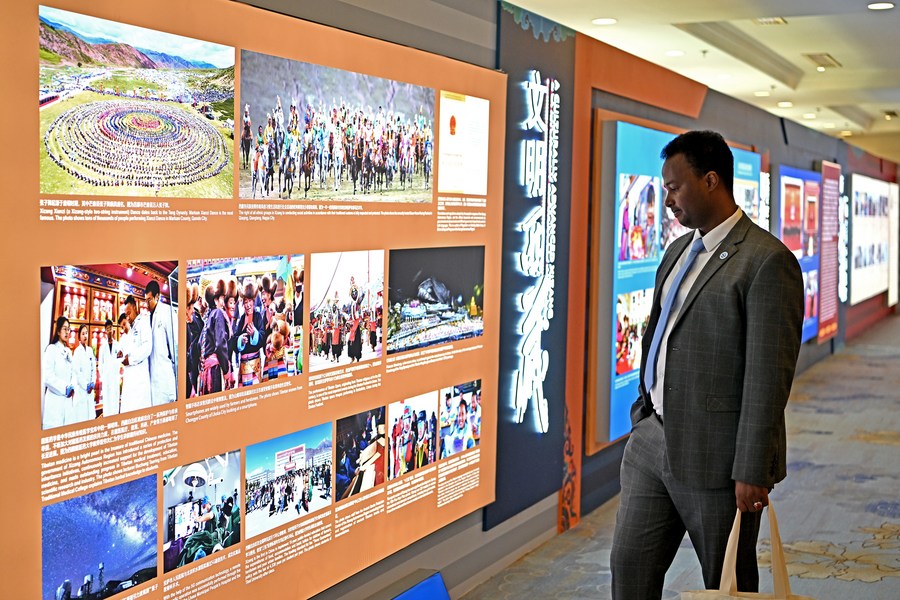
An attendee views an exhibition outside the venue of the 2023 Forum on the Development of Xizang in Beijing, capital of China, May 23, 2023. (Xinhua/Li Xin)
BEIJING, May 24 (Xinhua) -- The regional library of southwest China's Tibet Autonomous Region had digitalized more than 20,000 folios of ancient texts as of last week since its latest round of ancient document digitalization was launched in 2022.
According to a survey conducted in 2021, China is estimated to have kept hundreds of thousands of ancient documents written in the Tibetan language. Over half of these documents are now preserved in various locations, including Tibet's majestic Potala Palace, Drepung Monastery, Norbulingka, Sakya Monastery and other key ancient text protection sites, as well as over 1,300 temples in its county-level areas.
On Tuesday, China held the Forum on the Development of Xizang in the Chinese capital of Beijing. Among the event's sub-forums, several officials, experts and scholars centered on the conservation, inheritance and development of Tibet's culture, discussing key cultural protection projects in the region, including those related to ancient texts, Tibetan Buddhism and Tibetan medicine.
During a sub-forum on the region's cultural protection work, Su Faxiang, professor and dean of the School of Tibetan Studies at the Minzu University of China, noted the great importance of ancient texts preserved in Tibet's regional library and the region's latest progress on the digitalization of the documents.
"As a precious form of cultural heritage, ancient books become more and more precious as time goes by. To protect the old texts is to retain the roots of culture," Su said.
Now, with a few clicks on the regional library's website, one can easily access its database of Tibetan documents. The database covers texts including biographies of ancient Tibetan scholars and monks of various sects of Tibetan Buddhism, historical Tibetan documents, and documents recording the history of exchanges between Tibet and other regions of China. The rich content of the texts spans mainly from the 12th to the 20th centuries.
"The ancient texts are no longer confined to our stack rooms, with complicated procedures needed to borrow or read the documents, but they are now able to be shared worldwide," said Penpa Tsering, deputy director of the regional ancient book protection center.
"The digital protection and utilization of the ancient books in Tibet not only helps make better use of the preserved resources, but, more importantly, it realizes the initial intention and ideals of the ancient texts -- publicizing the precious documents around the world and serving academia and society," Penpa Tsering said.
Online access to the ancient collections is credited to Tibet's digital preservation efforts, which have lasted years. The survey of the precious texts, which relies heavily on manpower, remains the premise of digitalization.
In 2009, Tibet launched its largest-scale ancient document survey campaign. Over a decade, census workers covered almost all of the region's more than 1.2 million square kilometers of land.
"To date, the region has basically completed the survey and registration of its ancient books, involving more than 1,160 collection units and individuals in prefecture-level cities, with a total of 13,700 pieces of information collected," said Dekyi Drolkar, head of Tibet's culture department, during a sub-forum of the Forum on the Development of Xizang.
It is fair to say that Tibet has initially formed a system for the survey and preservation of ancient books, with the regional ancient book protection center at its core, the official added. And cultural departments in prefecture-level cities and counties, collection units and individuals have been the main participants.
Since 2017, the regional library, one of the region's major cultural relic protection forces, has expanded its ancient text digitalization project several times.
Pooling approximately 2.38 million yuan (about 340,000 U.S. dollars) in investment, it plans to complete the digitalization of more than 67,000 folios from over 610 ancient texts.




 A single purchase
A single purchase









